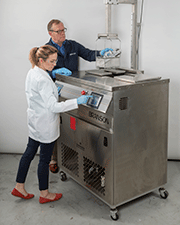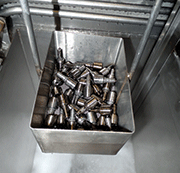E-Archive
Articles
in Vol. 20 - May Issue - Year 2019
"Score" Your Cleaning Methods

Vapor degreasers offer efficient high-volume cleaning

Focus your cleaning evaluation on ‘total cost per part’ cleaned
Successful cleaning methods are critical in ensuring components work as they should. One example of this within the product finishing industry is metal cleaning. When using treatments like plating or anodizing, metal components must be perfectly clean prior to painting, plating, welding or subsequent processing. The optimal metal cleaning process needs to dissolve or displace common contaminants without damaging substrates – so how do you find an efficient method?
When looking at cleaning processes, it is important to develop a cleaning ‘scorecard’ which will help you in your decision. A cleaning scorecard focuses on ‘total cost per part’ cleaned. When choosing a cleaning process, some companies only consider the cost of a machine or a drum of solvent, believing the least expensive machine or the lowest cost per liter is the best choice.
When scoring your long-term cleaning method, health, safety, and environmental regulations must be a priority and will influence your choices. Regulatory laws are continually changing making the selection of cleaning fluids more challenging and the risks of making an incorrect choice higher. Decision-makers should take this into consideration and invest in cleaning methods that have long-term stability.
The Importance of Cleaning Capacity
Next, consider the cleaning systems. Don’t look at equipment by its physical size, consider its production or cleaning capacity. How many units can be cleaned per hour or day? Alternatively, estimate the total surface area of all the parts to be cleaned. It is important to remember that some components may need different cleaning methods. If they are intricate or fragile, your cleaning processes may differ.
Once a cleaning capacity ‘score’ has been determined, look at the technology being used. This may be a vapor degreaser - good for efficient high-volume cleaning, but larger and more expensive than other methods like benchtop cleaning machines, which are slower, smaller and less expensive.
Consistent Cleaning
A vital calculation to consider is the consistency of the cleaning process. It is important to understand the value of a simple, consistent and sustainable cleaning process as better cleaning methods will play a key role in your final score.
When it comes to consistent cleaning, the use of modern cleaning fluids scores highly against other processes like aqueous cleaning. The benefits of vapor degreasing are clear as it is a simple process that uses sophisticated, low-boiling chemistry to remove contamination. A huge advantage is the reduction in analytical work required to ensure cleaning is effective. Aqueous systems typically require engineers to constantly monitor results to ensure they are within operating parameters. Cleaning fluid cleaning, however, saves on this cost implication, minimizing production costs, whilst meeting all the critical cleaning requirements.
Try Before You Buy
You have recorded your scores and found the best possible equipment for your production needs. However, it is recommended that you test this technology. Ask equipment manufacturers to run trials. Request sample reports on the cleaning process, cleaning fluids, temperatures, times and results to ensure the system performs to your specification.
It is important to calculate the average productivity of the system in terms of assemblies per hour. This is crucial to estimating the cost-per-part-cleaned as operational and labor expenses are usually tabulated as hourly costs.
Look at the cycle times to give an average throughput score. This is defined as the duration of one complete cleaning cycle, including loading and unloading.
Compare total cleaning costs from each machine, including the cost to purchase and set-up the machine, to consumables like water, cleaning fluids, and electricity. Re-calculate the figures into one standard unit of measure to give the total cost per part cleaned.
Don’t Forget Operating Costs
When the throughput score has been defined, work out the operating costs, for example, ’drag-out’. This is the loss of cleaning fluid when trapped in, on or around the cleaned parts as they move through the system. High-boiling solvents like water and hydrocarbons like nPB or TCE are prone to high drag-out losses, but such chemicals are relatively inexpensive. Low-boiling fluorinated solvents, although typically more expensive, can minimize drag-out losses.
Reduce drag-out by incorporating equipment that takes this into consideration. Some vapor degreasers use added features like extra refrigeration, superheat and hoists to reduce losses and save money. Aqueous systems use air-knives and extra drying chambers which reduce drag-out, but are costly on utility usage.
Remember hidden costs like labor and maintenance. Automated equipment is thought to save time on labor, but don’t forget to account for the technicians performing inspection, re-cleaning and drying of the parts.
Maintenance costs can also vary. Machines like some aqueous systems have many moving parts and processes from water-treatment and recycling to the alkaline additives used to boost the cleaning power. All of this must be maintained.
Some vapor degreasers will require filters to be replaced and the cleaning fluid in the degreaser needs to be boiled down and removed; however, when properly designed, equipped and configured, will out-perform the cleaning efficiency of any other cleaning technology.
Scorecard Checklist
To sum up, remember it is the total cost-per-part-cleaned that is important. Design your cleaning scorecard around these important calculations to find the cleaning process that works effectively for your needs.
Ensure the products adhere to regulative scrutiny.
Consider the cleaning requirements and how they may change. Average those into a daily or hourly rate of required throughput.
Compare different cleaning technologies. Send samples to the equipment makers to prove the ability of their systems in cleaning the components to your specifications.
Examine up-front capital costs, including everything from floor space and installation costs, to energy, fluid and labor costs.
Is your cleaning consistent – do you have clean components every time?
Convert all the cost data into a performance index of ’total cost per part cleaned’.
Select the option which minimizes total cost-per-part cleaned.
For Information:
MicroCare Corporation
595 John Downey Drive
New Britain, CT, USA 06051
Tel. +1.860.827-0626
E-mail: Support@MicroCare.com
www.microcare.com



























